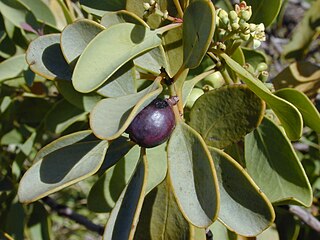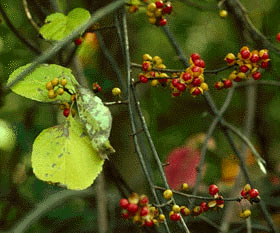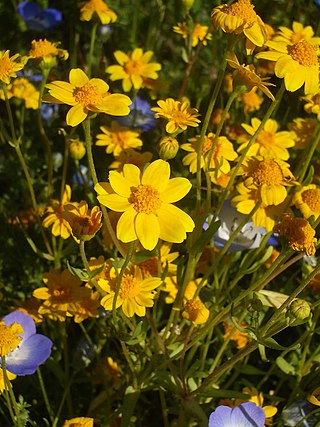
The Santalaceae, sandalwoods, are a widely distributed family of flowering plants which, like other members of Santalales, are partially parasitic on other plants. Its flowers are bisexual or, by abortion, unisexual. Modern treatments of the Santalaceae include the family Viscaceae (mistletoes), previously considered distinct.

The Celastraceae are a family of 98 genera and 1,350 species of herbs, vines, shrubs and small trees, belonging to the order Celastrales. The great majority of the genera are tropical, with only Celastrus, Euonymus and Maytenus widespread in temperate climates, and Parnassia (bog-stars) found in alpine and arctic climates.

Rancagua is a city and commune in central Chile and part of the Rancagua conurbation. It is the capital of the Cachapoal Province and of the O'Higgins Region, located 87 km (54 mi) south of the national capital of Santiago.

Estadio El Teniente, also known as Estadio El Teniente-Codelco for sponsorship reasons, is a multi-purpose stadium in Rancagua, Chile. It is currently used mostly for football matches. The stadium can fit 14,087 people and was built in 1945 with the name Braden Copper Company Stadium (Estadio Braden Copper Co.). The stadium is home to football club O'Higgins, which is based in Rancagua.
O'Higgins Fútbol Club, also known as O'Higgins de Rancagua, is a Chilean professional football club based in Rancagua, that currently plays in the Campeonato Nacional. The club's home stadium is Estadio El Teniente, opened in 1945 and renovated for the 2015 Copa América, which was hosted by Chile.

Sicyos is a flowering plant genus of the family Cucurbitaceae. Members of the genus may be known as "burr cucumbers", but the genus includes Sicyos edulis which is the christophine or chayote.

Lasthenia, commonly known as goldfields, is a genus of flowering plants family Asteraceae. The genus is named after Lasthenia of Mantinea, a cross-dressing female pupil of the ancient Greek philosopher Plato.

Loasa is a genus of flowering plants in the family Loasaceae. The genus contains about 100 species native to Central and South America. Species of Loasa are prickly herbs or shrubs that have nettle-like stinging hairs. Some species of Loasa are grown as ornamental plants and are known as Chile nettle. Its flowers have five yellow petals covering united stamens and distinctive large coloured nectaries. Caiophora is a closely related genus that also has stinging hairs and is found on rocky slopes of the Andes.

Pluchea is a genus of flowering plants in the tribe Inuleae within the family Asteraceae. Members of this genus might be known as camphorweeds, plucheas, or less uniquely fleabanes. Some, such as P. carolinensis and P. odorata, are called sourbushes. There are plants of many forms, from annual and perennial herbs to shrubs and trees, and there is variation in the morphology of leaves, flowers, and fruits.

Amblyopappus is a genus of flowering plants in the family Asteraceae described as a genus in 1841.

Madieae is a tribe of flowering plants in the family Asteraceae. It is sometimes considered a subtribe of Heliantheae. Notable species include the tarweeds of the Western United States as well as the silverswords of Hawaii.

Rhodophiala was a genus of herbaceous, perennial and bulbous plants in the Amaryllis family. It consisted of about 30 South American species distributed in southern Brazil, Argentina, and, specially, in Chile. Most of the species are known colloquially as añañuca. It has now been submerged in Zephyranthes.

José Santos Arraño Acevedo was a Chilean journalist and historian, who worked in several regional newspapers, including El Rancagüino from Rancagua, La Discusión from Chillán, amid others. He also wrote two books on the history of Pichilemu: Pichilemu y Sus Alrededores Turísticos and Hombres y Cosas de Pichilemu.
Hedyotis (starviolet) is a genus of flowering plants in the family Rubiaceae. Many species of this genus such as Hedyotis biflora, H. corymbosa and H. diffusa are well known medicinal plants. Hedyotis is native to tropical and subtropical Asia and to islands of the northwest Pacific. It comprises about 115 species. The type species for the genus is Hedyotis fruticosa.

The 2010 Pichilemu earthquakes, also known as the Libertador O'Higgins earthquakes, were a pair of intraplate earthquakes measuring 6.9 and 7.0 that struck Chile's O'Higgins Region on 11 March 2010 about 16 minutes apart. The earthquakes were centred 15 kilometres (9.3 mi) northwest of the city of Pichilemu.
Tweedia is a genus of flowering plants in the family Apocynaceae, first described as a genus in 1835. The genus is native to South America. An ornamental plant, Oxypetalum coeruleum, formerly included in this genus is commonly referred to as "tweedia".
- Tweedia andina(Phil.) G.H.Rua - Chile
- Tweedia aucaensisG.H. Rua - Argentina
- Tweedia australis(Malme) C. Ezcurra - Argentina
- Tweedia birostrata(Hook. & Arn.) Hook. & Arn. - Chile
- Tweedia brunonisHook. & Arn. - Argentina, Bolivia, Paraguay
- Tweedia echegarayi(Hieron.) Malme - Argentina
- Tweedia solanoides(Hook. & Arn.) Chittenden - Argentina, Brazil, Paraguay, Uruguay
Phania is a genus of plants in the tribe Eupatorieae within the family Asteraceae.

The 2017 South American Under-17 Football Championship was the 17th edition of the South American Under-17 Football Championship, a football competition for the under-17 national teams in South America organized by CONMEBOL. It was held in Chile from 23 February to 19 March 2017.
The 2019 South American U-20 Championship was the 29th edition of the South American U-20 Championship, the biennial international youth football championship organised by CONMEBOL for the men's under-20 national teams of South America. It was held in Chile between 17 January and 10 February 2019.

Homalocarpus is a genus of flowering plants in the family Apiaceae, found in Chile. They are annual herbs with white, yellow, red or purple flowers.















